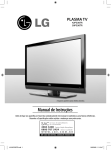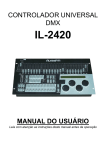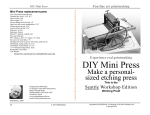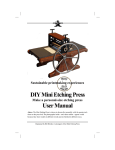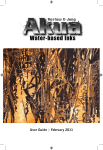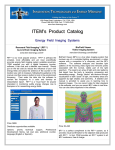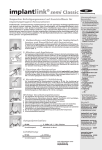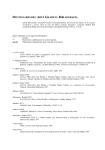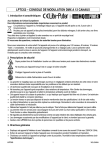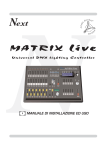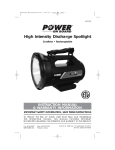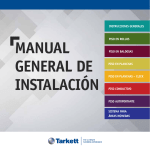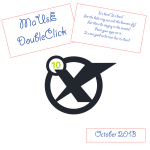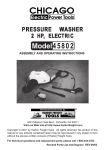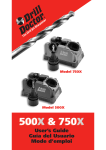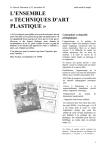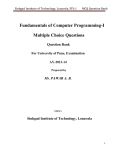Download USER MANUAL USER MANUAL
Transcript
Mini Etching Press USER MANUAL Assembled Care and operation of an etching press for printing small plates in intaglio, relief, vitreograph and monoprint/monotype printing methods. Mini Etching Press USER MANUAL Assembled Mini Etching Press - Model MEP6 Care and operation of an etching press for printing small-sized plates in intaglio, relief, vitreograph and monoprint/monotype printing methods, including type-high blocks. Shown above with removable chase for 1/4” X 5 X 7 printing blocks. Copyright 2014 Bill Ritchie Ritchie’s Perfect Press Division of Emeralda Works 500 Aloha #105 Seattle WA 98109 Press Bed The rack-driven bed is a polycarbonate measuring 1/4” thick, 6” wide and 14 1/2” long. To keep it like new it may be covered with thin adhesive plastic. Fine scratches or abrasion will not affect printing. Chase The chase is a 1/4” PVC frame cut to hold a 5 X 7-inch printing plate 1/4” thick. Use it with linoleum mounted on 1/8” backing. It also can be used for glass vitreography. Bottom roller The bottom roller (not visible in the picture) is 1 1/2” diameter and rolls on sealed bearings that never need lubrication. Felt Blankets included (but are not shown here) Two felt blankets come with the Mini Etching Press. One is the 1/8” thick woven pusher blanket and lays over the the thinner, 1/16” thick sizing catcher. The purpose of the pusher is to reach ink in texture and lines of images. The thin sizing catcher blanket absorbs moisture and, in some papers, sizing that is be squeezed from the damp paper under pressure. Hood The hood is a fitted wood covering crossing the top of the press. It conceals the synchonizing chain plus it is a convenient place to fold the blankets back, out of the way when placing the plate and papers on the bed. Pressure screws Two pressure screws press the top roller down for printing, and raise the roller to loosen them. Turn the pressure screw handles clockwise to increase pressure. A synchronizing chain connects the two pressure screws, but use both hands turning them tightly. Rack-driven bed There is a spur gear driving a rack on the underside of the bed that connect to the eight-inch driving wheel, producing the effect of a 3:1 mechanical advantage for easier of printing. 2 Side plates (active, passive) The side plates are made of hardwood and attach to the press with six barrel nuts, holding the press high enough for operating the wheel. Tie rods Tie rods connect the two side plates and they also support the press bed on 8 roller bearings on four long threaded screws (not visible in the photo) conncecting the steel side plates forming a rigid casing around the rollers and setting the precise tension on the synchronizing chain.. Rollers (Top and Bottom) Rollers top and bottom are 1 1/2” steel on roller bearings. Synchronized pressure screws raise and lower the top roller. The synchronizing chain keeps the roller level, assuring uniform printing pressure across the width of the plate. Wheel and Wheel hub set screw The 8” stainless steel wheel drives the gear that meshes with the bed’s spur gear and engages the bed rack. The wheel hub has a 1/4” set screw in it that is seated in a flat spot in the shaft. This set screw must be kept tight or the wheel can slip. A 1/8-inch Allen wrench (hex key) is included. Never use a worn out hex key. Allen wrenches New Allen wrenches (hex keys) are included are for the set screw on the driving wheel hub (1/8”) and also for the two (5/64”) on the spur gear and collar retainer on the shaft under the press bed. Never use a worn allen wrench because it can render the set screws un-removeable. Allen wrenches that are worn, with their corners rounded, must be discarded. Never use them if you see the edges are rounded over. They slip inside the socket and then socket’s inside will be rounded, too. Then the setscrew has to be removed with special tools and this is costly. If in doubt, replace the allen wrench with a new one available at all hardware stores. Be sure you buy inch, not metric Allen wrenches. 3 More notes about Allen Wrenches (hex keys) and set screws for the Mini Etching Press These notes are for the owner’s benefit to insure against the four important set screws loosening and allowing the driving wheel or spur gear to slip. One is on the driving wheel and three set screws are on the driving shaft under the press bed - two on the important spur gear and one in the collar. They were tightened in manufacture and tested. These notes will help users and for troubleshooting. Allen wrenches, or hex keys, are for set screws For the Mini Etching Press there is a simple checkup procedure you can follow to keep set screws and socket screws tight, insuring that the spur gears, collar and driving wheel never slip on the driving shafts. The arrow points to a flat spot on the driving shaft, put there to give a better hold for the 1/4-inch Allen set screw. If it is necessary to remove the wheel, be certain when replacing the wheel that the set screw is aligned on this flat spot. The illustration shows the larger hex key in the set screw on the driving wheel. The set screw is aligned with a flat place on the shaft. Mini Etching Press 1/8” hex key - larger one The driving wheel set screw on the hub of the driving wheel is easy to see, shown in the illustration with the 1/8” hex key in place. You always turn the set screw clockwise to check tightness. 4 The left illustration shows the 5/64 hex key fitted in one of the two set screws in the spur gear to check that the set screw has not worked loose during long usage of the press. Check both set screws on the spur gear to be sure they are tight. The illustration on the right shows the 5/64” hex key set in the collar on the end of the shaft. It is less likely to work loose, but it should be checked also. Mini Etching Press 5/64” the smaller hex key The bed must be move all the way back, or removed, to get access to these set screws. New Allen wrenches are included to check the set screws periodically to be sure that they have not worked loose after long use of the press. Two set screws on the spur gear insure there will be no slippage of the driving shaft. The tightness of the set screws on the spur gear is very important. It is good to check them at intervals according to how long the press has been in service. The illustration shows one set screw in its place on the spur gear; note that there are two set screws set in this gear. Use the smaller, 5/64” hex key to check and tighten them. Turn clockwise to tighten. Make sure they do not work loose. The other end of the shaft is a collar which is held in place with one set screw. Use the 5/64” hex key on the collar also, Never use worn-down hex keys Allen wrenches that are worn, with their corners rounded, must be discarded. Never use them if you see the edges are rounded over. They slip inside the socket and then socket’s inside will be rounded, too. Then the setscrew has to be removed with special tools and this is costly. If in doubt, replace the allen wrench with a new one available at all hardware stores. 5 Care of your press Pressure settings With practice you learn how much pressure is needed to print your plates. The press is designed to produce prints from plates in thickness from .028” to 1”. Thick plates present challenges. You must never tighten the pressure screws so much that the resistence of the wheel is so strong that it can damage the shaft or related parts. If you think your wheel or gears are slipping or if you have any sort of difficulties, or you have suggestions for better practices, then contact me via email or phone, [email protected]. Sometimes when the bed moves but the blankets and plate do not, the problem is usually too much pressure on a thick plate, and not the driving mechanism slipping. Another cause is too little or no bevel on the plate edge. Your plates may need more beveling, or the plate is too thick. I put a damp piece of newsprint under the printing plate. This is a good ideas especially if you removed the temporary plastic cover from the bed and are using the bare, polished surface of the polycarbonate press bed. The danp paper puts the brake on plates that want to skid. Cleaning The press bed may need cleaning after printing a plate if the plate had ink or dirt on its underside when it went on the bed. The bed may become scratched over time with repeated printing and cleaning, but this does not affect its performance. If you want to maintain a “like new” bed, put paper, plastic or thin metal on the bed to protect it when you print. If you use an adhesive plastic to cover the bed, or it was covered with an adhesive plastic when you got it and a plate wrinkles the plastic, there is no harm except if you leave it like that an put a plate on top. It will crease the plate--not good. Remove the plastic. Any adhesive that remains will probably come off with odorless mineral spirits; do not use strong solvents that might dissolve the polycarbonate bed. Lubrication The four bearings on each of the rollers are sealed. The bed moves on the 8 sealed little bearings on the threaded rods. No lubrication is necessary. The pressure screws may need a drop of oil on their threads, but rarely. The chain should never need oil. Wood care The wood parts of the press’ sides are crafted in various hardwoods that were oiled and need no care. They were oiled with teak or tung oil, and you may apply again or use furniture polish. Limit your leverage to reason The Mini Etching Press is strong enough for printing normal plates. People have been known to go to extremes, however, including putting too much pressure on the driving wheel. Do not use so much force that you have to use extra leverage. If you do, you may break the press or warp the wheel if you do. Never use an extra lever, such as a bar, to force the wheel. If you meet with strong resistance when printing or the wheel won’t turn, or it turns but the bed does not move and it can be because the pressure screws are too tight for your plate and paper. When the printing plate is too thick and not well-beveled, the set screw in the hub of the driving wheel can slip. Try using less pressure. 6 Printing with the Mini Etching Press The Mini Etching Press is capable of printing all four printing processes, alone or in combination, plus monoprints and monotypes, too. These presses were designed to serve mainly as an etching press for intaglio printmaking, and the designer made many YouTube videos to demonstrate intaglio printing online. Intaglio: The plate Intaglio printing plates are often metal, plastic, wood, linoleum, glass, paper or a collage of different materials (collagraph). If you have no experience in making a plate for printing intaglio, look on YouTube or a book or video about intaglio printing. The preferred thin plate for traditional etching is 22-gauge copper, etched with ferric chloride. It is customary to ink with intaglio ink and then wipe the excess off with paper or a non-absorbent fabric such as tarlatan, then finish with clean paper and the heel of the hand. YouTube videos online show you how, but these illustrations are of the steps for printing intaglio. Felt blankets Your press comes with two felts. One is 1/8” thick and has a visible woven fibre in it; it’s called the pusher felt. The second, which goes next to the printing paper, is 1/16”, softer, and is called the sizing catcher. The felt blankets are cut to fit the Mini Etching Press, which has a 6” wide bed. It helps if the two felts are stair-stepped to begin. Slip them under the roller and tighten the pressure screws down with two hands. The screws are synchronized, but use your two hands as the pressure increases. The chain is strong steel, but you should not stress this chain by using only one hand one one pressure screw. Two felt blankets are used when printing intaglio and sometimes other printing processes. They are almost 100% wool, so if they are washed they must be washed in cold water. Adjusting the pressure screws Turn the pressure screws clock-wise to tighten. The illustration shows the felt blankets are under the roller when you set the pressure, and use two hands so the chain is not stressed. 7 Adjust pressure using both hands. Count the turns - or halfturns - so with practice you can learn what is the best pressure for you plate, ink, and paper. There is no mathematical rule to follow. The correct pressure must be learned by experience. See YouTube videos by Bill Ritchie to understand this. When on the YouTube website, input HALFWOODPRESS and also OMEMERALDA for examples. The resistance during printing gives you an idea how tight to make the pressure. You will get a feel for this with practice, and it depends on how thick are your printing plate and paper. The thicker the plate and the paper, the more space you need between the roller and the bed. Pressure will also be affected by the width your printing plate. The test plate in the illustration was made 5 inches on one dimension to make use of all but 1/2 inch of the 6-inch Mini Etching Press bed. Compare this to a plate two inches wide - it will feel like less pressure. Felt Blankets and also the paper Put a piece of damp newsprint under the plate first, the put the plate on this damp paper so it will not slide. The felt blankets and pressure are ready, and in the photo the paper edge is under the roller, too, and then folded back. to make room for the plate. Put a piece of damp newsprint under the printing plate. This helps two ways: it keeps the bed clean as there may be ink on the back of the plate. Also, the plate will not slip if it is on thin, damp paper. Good practices printing With one end of the felts under the roller and the pressure screws tightened down, fold the felts back over the hood to give you room to place the plate and paper.Then put the felts over the paper and slowly turn the wheel. You will feel resistance when the plate reaches the roller. If it stops and you can’t turn the wheel, then the pressure is too great; or, the plate has not been beveled enough to let the roller up over the the edge. As you continue turning, Examine it for tone, clean, full lines that show you should not stop or it might uniform, adequate pressure. make a line. When the roller comes to the end of the plate you’ll feel the resistance give away. When you feel the roller drop off the end of the paper’s edge, you can gently and slowly pull the print off the plate. This is called, “pull the proof.” For another print, you will re-ink and wipe the plate for every print. There is another practice to know: instead of pulling the proof after one time through, you may run it through two times; in other words, reverse the direction. You may even get a better print by running it through twice. Long plates, however, such as 10 inches, will blur because damp printing paper stretches, so it shifts if printed it twice. Multiple plates Multiple plate prints require registration. For example, you may have two plates, one for each of two colors. You need a book or video to explain and demonstrate registration - space does not allow it in this manual. Between colors or at the end of your printing session you should clean your plate using nontoxic solvents such as cooking oil and soy-based cleaning products. Check the press bed for ink or dirt that might have transferred from the backs of your plates if you did not use damp paper. Loosen the pressure screws and remove the felts so the sizing catcher 8 can dry. Never leave the felts under the roller for a long time. If you leave the felts under the roller and in the center, for example, the pressure will impress a place in the blankets and interfere with even printing pressure later on. Also, moisture in the felts will make a rusty line on the roller. The space in this manual does not allow for other printing methods— stencil, relief, planographic, monotypes and mono prints. There is, however a section following on uses of the chase. Uses of the chase The chase that is included with the press is a plastic (PVC) 1/4” frame with a 5” X 7” cut-out that makes it easier to print relief or surface printing techniques.With the chase on the bed, you can print a relief block up to 5 X 7 inches for plates 1/4” thick or under. The illustration shows a 5 X 7 X 1/4” woodcut block set in the chase, and a relief print being pulled. In this illustration, one felt blanket was in use, too. To have a flat print (no embossing) then the felt blanket is not used, but instead a thin matboard covering. Unmounted linoleum is available in pieces or by the roll. It measures about 1/8thinch thick. By glueing it with Qurter-inch plywood, or laminated wood, fits contact cement to a 1/8” back in the chase. SafeTKut and acrylic plates plus - such as 1/8-inch plywood numrous other block making materials exist, - you have a 1/4” mounted including collagraphs, can be used in the cahse linoleum block that fits in the if they are 1/4” thick. 5 X 7-inch chase. Planographic printing When the printing surface is flat and the image is made by drawing or transfer methods, the printing process is called planographic because unlike intaglio, relief and stencil printing, everything is on one plane. Stone lithography was the first process invented. Metal plates took the place of stone. Vitreography uses either quarter-inch ground Then the water that was part plate glass or frosted Mylar and is waterless. of the printing process was eliminated and called “waterSimilar planographic techniques use polyester less lithography.” plates which can use a computer printer for typography and photo images, but the plate must In waterless lithography, be dampened all the time you print. silicon replaced the water because, when dry, silicon resists oil and varnish-based inks. Ground-glass, (hand ground by graining plate glass) and Mylar are used in waterless lithography printing and, on groundglass, it is called vitreography. Polyester plates are similar to Mylar but they require a water-base moisture layer like old-time lithography. Popular brand names sold by art materials stores are Pronto and Smart plates. These plates work in laser printers, so they are popular for photos and typography because software allows you reverse these for direct printing. 9 Stencil, or Pochoir Pochoir (stencil) methods plus monotypes (and monoprints) work on this rack-driven bed press. Monotype can be done on a 5 X 7 X 1/4 inch material of any kind. Plastics are popular for this. The method is really a transfer painting technique but many people think it is a printmaking method. Monoprints, unlike monotypes, are true prints but there may be only one; that’s This is an example of pochoir, where a stencil why they are called monowith a triangle-shape was cut in a window, and prints. the person making the place over a roller pattern from a brayer on monoprint chooses to use a true printing plate, but enjoys another plate. The color only prints through the creativity of changing the window. colors and printing methods from one impression to another. Thus, you may make many monoprints from one true printing plate, but they may not be identical as they would be if they were for an edition of multiples. Type-high relief blocks Thicker blocks up to .918-inch (type-high) require a thicker chase or type-high rails place alongside; a type-high block the same size as the bed is shown in an illustration. This block is mounted linoleum. Wood engraving blocks for professionals are type-high. If a small wood engraving block or linocut is your printType-high means that the printing block ing plate, then you need to put it is the same as moveable type from between two long narrow type-high traditional letterpress printing. Mounted pieces like railing on each side linoleum is sold by companies such as of the small block. These can be Speedball. The illustration shows a block wood which you have built up to be the same height as your type-high the same size as the press bed. block. The purpose of the chase is to put pressure on the sides so you don’t have to guess what pressure to use when you begin. Wthout the railings or a chase, the bed will move along but when the block comes under the roller, it may stop, or tip the block, or not have the right pressure. Most models of the Mini Etching Press can take the type-high block with the exception of the first six Mini Etching Presses that were released in 2013 before the modification was made so the press could take type-high blocks. 10 Resources Search for HALFWOODPRESS and OMEMERALDA on YouTube search bar For videos, go to YouTube on the Internet and enter the one-word terms HALFWOODPRESS or OMEMERALDA in the search box. Short videos on printmaking are there for you to see and, if you wish, ask questions too. Replacements and options It’s inevitable that user’s will have questions about replacing things that came with the press, such as blankets or test plates. Send e-mail if you wish to order one of if you have any other needs or suggestions. Books Halfwood Press: The Story is my account of the early days of my pressmaking venture. This is included with purchase of the press, and additional copies are available at amazon.com. Another publisher, Crown Point Press, published several volumes of books with DVDSs which include extensive and detailed explanations of printmaking techniques used in this San Francisco printing house. The DVDs show the processes live. Skype My skype name is bill.h.ritchie, and in my gallery I have a computer and cam, so it is possible to have conversations. If you want to try this, let me know the day and time so I can make my schedule accommodate this kind of contact. Web sites Web sites are: www.printmakingworld.com www.ritchie-art.com 11 Specifications of the Mini Etching Press Overall dimensions: Overall press length: 15 in. Overall press width: 10 in. Overall press height: 11 in.. Bed length: 14.5 in Bed thickness: 1/4” Polycarbonate Bed width: 6 in. Effective Printing Width: 5 inches or up to 6 inches Rollers Diameter: 1 1/2 in. Clearance from Bed: 1 1/8 in. Wheel Diameter: 8” Mechanical advantage, approx. ratio: 3:1 Bed Support Bearings: 8 Weight (lbs): 10 lbs. approximately Felt Blankets Sizing catcher 5 3/4” X 12”. X 1/16” thick Pusher blanket, 5 3/4” X 12”. X 1/8” thick woven Allen (Hex) Wrenches: 1/8” and 5/64” with instructions User manual These specifications are subject to change without notice. Note: This manual is based on similar user manuals for the Halfwood Press Line of etching presses. The online version is in color and may not perfectly match the content on these pages. Examples in the photos were made of different presses and at different times and therefore they may vary in appearance from the owner’s press. 12 2 er Plane Safe 202 Earth gs arnin ts’ W ientis ’s Sc arth ed E ts he Artis t Flow An EarthSafe 2022 Project by Bill Ritchie Mini Etching Press Model MEP6 Assembled User’s Manual Copyright 2014 Bill Ritchie All Rights Reserved Perfect Press Division of Emeralda Works - Seattle Made in USA 13














